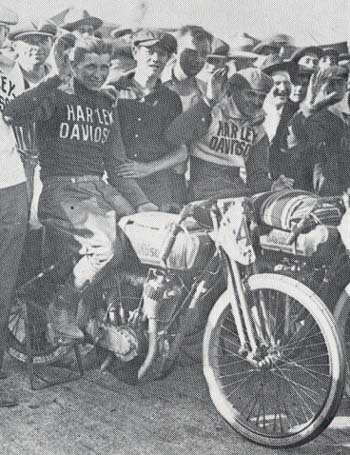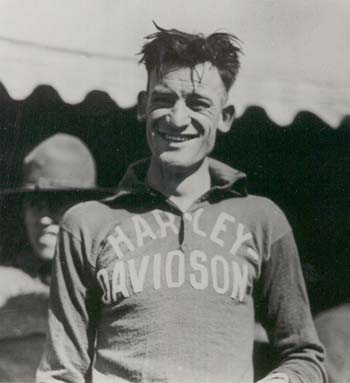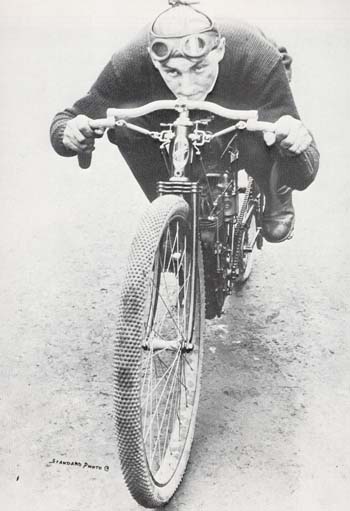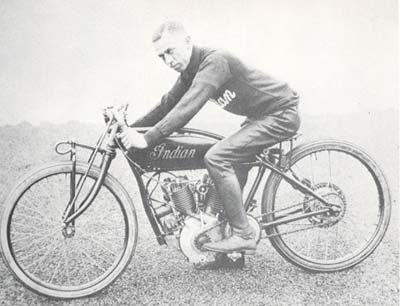by Daniel K. Statnekov |
| ©1998 - 2006 Daniel K. Statnekov |
|
In the Fall of 1916, all of the manufacturers agreed to suspend factory
supported competition. This action was taken because of the increasing
likelihood that the United States would be drawn into the war that had been
raging in Europe, and the need to prepare for defense contracts.
Record attempts continued, however, under the sponsorship of individual
dealers.
Amateurs as well as former factory professionals made sporadic efforts to shorten the time it took to ride from Canada to Mexico or tried for a new inter-city record. Occasionally, the now silent board tracks were awakened by the lone exhaust note of a specially prepared machine that was trying for a new 24-hour record. Interest in racing diminished, and in 1918, following a benefit race in Grand Island, Nebraska, Don Johns retired from motorcycle racing. The man who would be remembered best for his legendary rides on the speed demon Cyclone was 23 years-old at the time of his retirement. In 1919, the three major manufacturers committed themselves to a strong post-war competition program. By this time most of the smaller bike builders, the ones who had rounded out the field in pre-war races such as Dodge City, had dropped by the wayside. It was now "officially" a three sided race: contested on the race track as well as in the marketplace. Bill Ottaway "hit the ground running," and assembled for Harley-Davidson a formidable array of talent. The first big event of the year was held in June, at Ascot Speedway in Los Angeles where the Harley-Davidson team swept the first five places of the 200-mile National Championship. Of the sixteen riders entered, only eight finished; and it did not go unnoticed by the crowd of 10,000 spectators that only one H-D failed to complete the race.
Ottaway's careful preparation was evident in both the mechanical superiority of
the H-D equipment as well as his crew's performance in the pits. Ralph
Hepburn, the eventual winner, had his rear wheel changed and machine fueled
in just 38 seconds; while one of the Excelsior riders had oil poured in
his gas tank during a pit stop. This embarrassment necessitated that
the machine be turned upside down, in order to drain the tank and enable the
hapless rider to continue. The nearest Indian placed 6th.
Born in Massachusetts in 1896, Ralph Hepburn was another conspicuous member of that first "company" of boys who became fascinated with the motorized two-wheeler. If Ralph's family had remained in Massachusetts, Hepburn's career may have become intertwined with the fortunes of Indian, but in 1906 the 10 year-old boy moved to Los Angeles. Ralph was industrious and landed a job after school as a delivery boy, first on a bicycle and then with a motorized two-wheeler. When he was 16 years-old, Ralph began to race in local events, and in 1914 he gave up his "regular" job to ride the mid-west motor drome circuit. Later, on dirt tracks from Colorado to Kansas, he raced a "ported" Excelsior and 4-valve Indian, living off the meager prize money that he could win along the way. In June of 1919, just before the Ascot Championship race that would establish his reputation as a national star, the 23 year-old Hepburn became a member of the H-D team.
After the Ascot meet, the Ottaway-led team continued to win major events.
At the Marion, Indiana 200-miler in September, "Red" Parkhurst led the
Milwaukee manufacturer to a three place victory, Hepburn finishing 2nd and
Otto Walker 3rd. Indian mounted, Teddy Carroll, battled Parkhurst
for the lead throughout the 2nd half of the Marion race until his "Powerplus"
racer broke a valve spring in the next-to-the-last lap. Although the
Indian pit crew changed the spring in under 3 minutes, Carroll was forced
to settle for 4th place, still in front of the three nearest Excelsiors.
One of the motivating factors for Indian's development of the "Powerplus" was the Springfield company's frustration at seeing Harley-Davidson leap ahead on the race track. As mentioned earlier, in the Spring of 1915, shortly after the Harley-Davidson victory at the Venice 300-mile road race, Indian's senior management met with their engineering department to discuss the possibility of building a totally new motor, something that was capable of more power than what the Hedstrom motor could produce. Charles Gustafson, head of the Development Department, suggested that a well-designed side-valve might offer a solution. Before joining Indian in 1907, the self-taught practical engineer had been employed by the Reading-Standard Company where he had designed a side-valve that was based on the contemporary French Peugeot motor. The engineer's suggestion was accepted by Indian management which gave him the go ahead to proceed. The new Indian motor was configured to conform to the then standard 61 cubic inch displacement offered by the other manufacturers. Although the basic layout of the Hedstrom design was retained, there were significant differences, such as the side-valve configuration and an increased use of roller bearings, a feature that Cyclone had successfully employed. Introduced for the 1916 sales season, Gustafson's side-valve developed a substantial increase in horsepower over the Hedstrom model; consequently, it was designated as the "Powerplus."
To demonstrate the increased power and dependability of the new design,
Indian engaged Erwin "Cannonball" Baker to undertake an attempt on the
3-flag record, a timed distance race from Vancouver, Canada to Tijuana,
Mexico. In August of 1915, Baker broke the existing 3-flag record
and then traveled to Australia where he also set a number of timed distance
records. One week before "Cannonball" Baker set out to break the
3-flag, Canada to Mexico record, Earl "Red" Armstrong, riding an Indian
8-valve, won the inaugural 300-mile feature event at the Tacoma board track.
For high speed track racing, the Springfield company had determined that they would need more time to extract the full potential from their new motor. With the cessation of factory-supported motorcycle competition, Indian shifted their emphasis to war production. As far as track racing was concerned, the further development of the Powerplus would have to wait until the end of the war.
In September of 1919, at the post-war Marion, Indiana 200-mile road race,
several specially prepared Powerplus motors appeared in an all-new race
chassis. Following a style that Harley-Davidson had introduced in 1916,
the new Indian racing frame was open at the bottom, the engine
serving as a structural member of the chassis itself. Although
H-D's "Red" Parkhurst won the 1919 Marion race, Teddy Carroll's battle
with the winner served notice that the Indian side-valve would be a contender.
Edward "Teddy" Carroll was another member of that first generation of boys who had "caught the fever" to race a motorized bicycle. Teddy's youth was similar to that of his west coast rival, Ralph Hepburn. Born in 1894 in Springfield, Massachusetts, Carroll was raised almost in the shadow of the giant Hendee factory. At the age of twelve, the youngster made his first acquaintance with a "gasoline-fired" two-wheeler, and learned to ride with the "run, push, and jump-on style" that most boys needed to get their engines underway. As a later biographer wrote: "Many a tumble he took in the dust, but more than anything else, Teddy was determined to ride." By the time he was 15, Teddy had learned enough about motorcycles to get a job as a delivery boy, driving an Indian Tricar van, first for a laundry and then a department store. In 1912, he bought his first machine, a 7 horse-power Indian twin and with it entered a series of novice races at Springfield Stadium. During the next few years the enthusiastic teenager raced at county fairs in various parts of New England, earning for himself a collection of trophies and some small cash prizes. In 1914, Teddy Carroll realized his dream by landing a job in the testing room at the Indian factory. In April of 1915, the Springfield manufacturer furnished Teddy with an 8-valve with which he won his first professional race. In the process, the Indian rider beat several members of the H-D "wrecking crew" including Al Stratton and Irving Janke, and set a new track record for the Readville, Massachusetts track. In September, Carroll ran 2nd behind Carl Goudy in the famous 300-mile Chicago board track event, and in a follow-up 100-mile race in Milwaukee the Springfield rider again placed 2nd, this time behind H-D's, "Red" Parkhurst. Always a contender, and sometimes a champion, Edward "Teddy" Carroll was proud to wear the red and white colors of the Indian factory team. |
|
|
|
|
|
Webmaster: daniels@statnekov.com |
Page installed: Nov. 15, 1996 Page revised: June 28, 2003 |



